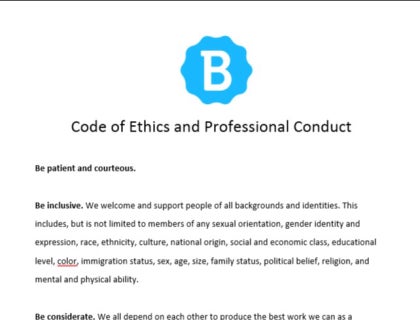Code of Ethics vs. Code of Conduct:
A code of ethics is broad, giving employees or members a general idea of what types of behavior and decisions are acceptable and encouraged at a business or organization. A code of conduct is more focused. It defines how employees or members should act in specific situations.
Can You Combine a Code of Conduct and a Code of Ethics?
Yes. In most cases, businesses will combine both of these documents into one as there is significant overlap between them. It is rare to find businesses that have two separate policies. Whilst they are technically different documents, employees will have less difficulty recalling important points around conduct and ethics if they have a single document to refer to.

Code of Ethics and Professional Conduct Download
Download this code of ethics and professional conduct sample in MS Word format.
Download SampleCode of Ethics and Professional Conduct Sample Template:
1. Be inclusive.
We welcome and support people of all backgrounds and identities.
This includes, but is not limited to members of any sexual orientation, gender identity and expression, race, ethnicity, culture, national origin, social and economic class, educational level, color, immigration status, sex, age, size, family status, political belief, religion, and mental and physical ability.
2. Be considerate.
We all depend on each other to produce the best work we can as a company. Your decisions will affect clients and colleagues, and you should take those consequences into account when making decisions.
3. Be respectful.
We won't all agree all the time, but disagreement is no excuse for disrespectful behavior. We will all experience frustration from time to time, but we cannot allow that frustration to turn into personal attacks. An environment where people feel uncomfortable or threatened is not a productive or creative one.
4. Choose your words carefully.
Always conduct yourself professionally. Be kind to others. Do not insult or put down others. Harassment and exclusionary behavior aren't acceptable. This includes, but is not limited to:
- Threats of violence.
- Insubordination.
- Discriminatory jokes and language.
- Sharing sexually explicit or violent material via electronic devices or other means.
- Personal insults, especially those using racist or sexist terms.
- Unwelcome sexual attention.
- Advocating for, or encouraging, any of the above behavior.
5. Don't harass.
In general, if someone asks you to stop something, then stop. When we disagree, try to understand why. Differences of opinion and disagreements are mostly unavoidable. What is important is that we resolve disagreements and differing views constructively.
6. Make differences into strengths.
We can find strength in diversity. Different people have different perspectives on issues, and that can be valuable for solving problems or generating new ideas. Being unable to understand why someone holds a viewpoint doesn’t mean that they’re wrong. Don’t forget that we all make mistakes, and blaming each other doesn’t get us anywhere.
Instead, focus on resolving issues and learning from mistakes.
What to Include in Your Code of Ethics and Professional Conduct:
A code of ethics and professional conduct consists of several key sections detailed below. You can cover all of them in a short summary Code of Ethics and Professional Conduct as we have above, or expand on them in detail so employees are clear on how to handle many common situations.
1. The work environment.
Employees should act with integrity, comply with laws, maintain a professional work environment and comply with company policies. They should treat customers, colleagues, and partners ethically at all times.
2. Conflicts of interest.
A company's reputation depends on the actions and integrity of its employees. It is essential that they avoid relationships and activities that hurt, or appear to hurt, their ability to make objective and fair decisions.
3. Protecting company assets.
Employees should always act to protect company assets, including physical, intellectual, and electronic or digital properties.
4. Anti-bribery and corruption.
A company's integrity is essential for maintaining trustworthiness and reputation. Employees should always do their work fairly, honestly, and legally.
5. Attendance and punctuality.
Employees are expected to be regular and punctual in attendance. This means being in the office, ready to work, at starting time each day. Absenteeism and tardiness burden other employees and the company.
6. Absence without notice.
Employees who are unable to work due to illness or an accident should notify their supervisor. This allows the company to arrange for coverage of their duties and helps others continue to work in their absence. If an employee does a report for work and the company is not notified of an employee's status for 3 days, it is typically considered a job abandonment.
7. General harassment and sexual harassment.
This company is committed to providing a work environment free of discrimination and unlawful harassment. Actions, words, jokes, or comments based on an individual’s sex, race, ethnicity, age, religion, or any other legally protected characteristic are not tolerated.
8. Cell phone use at work.
Personal cell phone usage during work hours is discouraged, except in extreme cases such as an emergency.
9. Dress code.
A professional appearance is important when employees work with customers or potential customers. Employees should be well-groomed and dressed appropriately for the business and for their position.
10. Substance abuse.
The manufacture, distribution, possession, sale, or purchase of controlled substances of abuse on company property is prohibited. Being under the influence of illegal drugs, alcohol, or substances of abuse on company property is prohibited. Working while under the influence of prescription drugs that impair performance is prohibited.
11. Tobacco products.
The use of tobacco products on company property, outside of permitted areas, is strictly prohibited.
12. Internet use at work.
Employees may use the internet when appropriate to access information needed to conduct company business. Use of the internet must not disrupt or injure the company computer network. Use of the internet must not interfere with an employee's productivity.
Conflict of Interest Code of Conduct Topics:
- Corporate asset contributions.
- Running for public office.
- Insider trading and financial interests.
- Investments in companies employees do business with.
- Employee political interests.
- Significant financial interests in other companies.
- Securities transactions.
- Taking out loans.
Anti-Bribery & Corruption Code of Conduct Topics:
- Doing business with governments.
- Choosing and maintaining service providers.
- Receiving gifts and entertainment.
- Loans, bribes, and kickbacks.
- Relationships with former employees.
- Obligations of departing and former employees.
- Interaction with competitors.
- Relationships with affiliates, international entities, and customers.
Company Assets Code of Conduct Topics:
- Preparing, maintaining, and disclosing accurate records.
- Information security.
- Protecting communication and information technology systems.
- Protecting external communications.
- Use of company property.
- Use of property owned by others.
- Facility security.
- Protecting intellectual property.
How to Write a Code of Ethics and Code of Conduct:
1. Review your mission statement and core values.
The goal of a code of ethics is to help employees make decisions that are in line with what the company or organization values. This should be distilled into your mission statement and core values, so it's a good place to start.
2. Talk to stakeholders.
What do management, employees, and clients think are the most important values of the company to uphold? Get input from everyone involved to be sure your code reflects what the company stands for. You can have them all look at a code of conduct template to get ideas for how their own might look.
3. Review past ethical issues.
Where has your company faltered with ethics in the past? Where has it shined? Call attention to problem areas and reinforce the strengths you already have.
4. See where other companies have faltered.
Have other companies in your industry had recent ethical failures? Avoid the same pitfalls by covering these issues in your code.
5. Create a draft code for input and discussion.
Give everyone a chance to help decide on the contents of the code of ethics by inviting them to discuss and give input on a draft.
6. Create a final draft and share it.
Once you've got a final draft approved, share it throughout the organization. Also, make sure that a copy of it is added to your employee handbook.
Work Environment Code of Conduct Topics:
- Equal opportunity.
- Discrimination and harassment.
- Violence policy.
- Safety policy.
- Substance abuse.
- Gambling policy.
- Privacy policy.
- Misconduct explanation and policy.
Code of Ethics and Professional Conduct Examples:
Company | Code of Ethics |
|---|---|
Alphabet | Employees of Alphabet and its subsidiaries and controlled affiliates (“Alphabet”) should do the right thing – follow the law, act honorably, and treat co-workers with courtesy and respect. |
Hershey | No matter what job you do or where you do it, you are Hershey. Think about that as you watch over every business relationship, every transaction, and every product, and make sure your actions always reflect our values. |
Starbucks | Starbucks empowers all partners to make decisions that impact our reputation. Individual actions at work shape how the world views Starbucks, which is why it’s so important that we each take responsibility for our Starbucks Mission and act ethically in all situations. |
Under Armour | Make the Right Call. It’s as simple as it sounds. Whenever you’re faced with a decision—big or small—always do what you know is ethically right, and, of course, always follow the law. |
Verizon | We know that bigness is not our strength, best is our strength. Bureaucracy is an enemy. We fight every day to stay “small” and keep bureaucracy out. |
The Importance of a Code of Ethics:
A code of ethics is important because it helps employees or organization members make decisions that are in line with company values in the absence of a clear rule or direct supervision. A code of ethics can improve decision-making at a business, and make it easier for employees to be autonomous.


